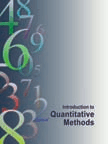Introduction to Quantitative Methods
 |
Details
Textbook:
Pages : 395;
Paperback;
210 X 275 mm approx.
Workbook:
Pages :
276; Paperback;
210 X 275 mm approx, Sample Applied Theory Questions
Sample Multiple Choice Questions (Online Quiz)
Pricing
Textbook Price: Rs. 900;
Workbook Price: Rs. 700;
Available only in INDIA
Detail Table of Contents
Click below to view
HTML
Index Numbers and Time Series Analysis : Chapter 9
SUMMARY: An index number is a statistical measure designed to show changes in variables or a group of related variables with respect to time, geographic locations or other characteristics of the variable under study. It is referred to as a measure of change, a device to measure change or a series representing the process of change. Index numbers are used as a barometer to indicate the changes in economic activity. They also provide framework for decision making and to forecast future events. There are three types of index numbers which are generally used. They are price index, quantity index and value index. These index numbers can be developed either by aggregate method or by average of relatives method. This chapter discussed various methods of weighting an index like the Laspeyres method, Paasche method, Fisher method and the fixed weight aggregates method. Although there are many problems related to developing an index it is a handy |
|
device to measure or compare the changes in economic variables over a period of time. The chapter discusses Quantity and Value Indices, Marshall Edgeworth method, Chain Index numbers, and various tests for consistency of Index Numbers. Time Series Analysis, Secular Trend and basic types of variations in relation to time series analysis including cyclical variation, seasonal variation and irregular variation are also explained.



